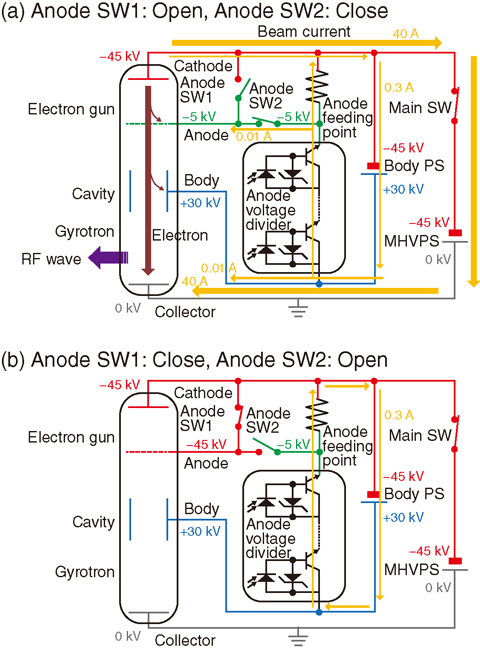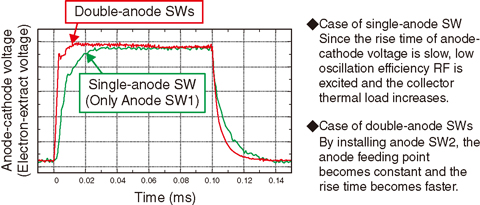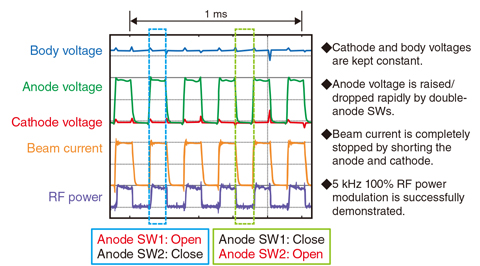
Fig.9-2 Fast power-modulation operation using the double-anode switches method. Circuit states in (a) RF-wave on-phase and (b) RF-wave off-phase are shown

Fig.9-3 Effect of double-anode switches

Fig.9-4 Demonstration of 5 kHz full power-modulation
In the International Thermonuclear Experimental Reactor (ITER), fusion plasmas are controlled and stabilized by applying a 170 GHz radio-frequency (RF) wave with a power of 20 MW. We have already succeeded in developing an ITER gyrotron that simultaneously satisfies the ITER requirements for an output power of 1 MW and an electrical efficiency of 50%. However, a neo-classical tearing mode (NTM) is assumed in ITER plasmas, and it generates magnetic islands that lead to the degradation of the plasma performance. Therefore, synchronized injection of 5 kHz RF waves onto the rotating magnetic islands in the plasma is required for the effective suppression of NTM. In a conventional scenario of fast modulation, power modulation is introduced into an RF wave by the changing acceleration voltage between a cathode voltage at an electron gun and a body voltage at a cavity. However, it is difficult to modulate the cathode voltage fed from a main power supply with a high voltage and large current. Therefore, the modulation of the body voltage is used because the body current is small. This modulation method alternately shifts the oscillation condition from the high-efficiency region to the low-efficiency region. Therefore, the thermal load to a collector increases due to the high-energy electron beam. Hence, variation of power amplitude is limited by up to 50% in the case of the 5 kHz power-modulation.
We have developed a new power-modulation method without the modulation of the acceleration voltage to resolve this limit. The JAEA gyrotron is a triode gyrotron with an energy-recovery mechanism. Electrons are extracted by a voltage between a cathode and an anode in an electron gun and accelerated by a voltage between a cathode and a body, and a spent electron beam is partially recovered by retarding the voltage between a body and a grounded collector. Electron extraction is easily stopped in the triode gyrotron by shorting the anode and cathode. Two fast-switches (SWs) with 1 μs rise/fall time are introduced between the cathode and the anode (anode SW1) and between the anode and the anode feed (anode SW2). Circuits using the double-anode SWs method are shown in Figs.9-2 (a) and (b) in the cases of on-phase and off-phase RF waves, respectively. Fig.9-3 shows the effect of double anode SWs. In the case of a single-anode SW (only Anode SW1), the rise time of the anode-cathode voltage is slow because the anode feeding voltage becomes the cathode voltage if the cathode and anode are shorted. By installing the Anode SW2, the anode feeding voltage can be kept constant and the rise time can be increased. As a result, the beam current is completely controlled by the double anode SWs and a 5 kHz 100% RF power modulation is demonstrated for the first time in the world, as shown in Fig.9-4. This result fulfills the ITER requirement.
<Previous: 9 Nuclear Fusion Research and Development | Next: 9-2 >